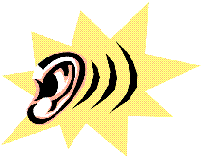
ScienceDaily (Nov. 27, 2009) — It is relatively common for listeners to "hear" sounds that are not really there. In fact, it is the brain's ability to reconstruct fragmented sounds that allows us to successfully carry on a conversation in a noisy room. Now, a new study helps to explain what happens in the brain that allows us to perceive a physically interrupted sound as being continuous. The research, published by Cell Press in the November 25 issue of Neuron provides fascinating insight into the constructive nature of human hearing.
"In our day-to-day lives, sounds we wish to pay attention to may be distorted or masked by background noise, which means that some of the information gets lost. In spite of this, our brains manage to fill in the information gaps, giving us an overall 'image' of the sound," explains senior study author, Dr. Lars Riecke from the Department of Cognitive Neuroscience at Maastricht University in The Netherlands. Dr. Riecke and colleagues were interested in unraveling the neural mechanisms associated with this auditory continuity illusion, where a physically interrupted sound is heard as continuing through background noise.
To view the entire article. please click on the link above.
No comments:
Post a Comment